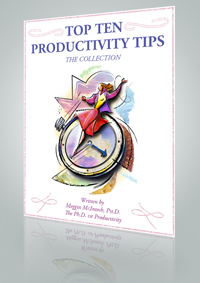Top Ten Tips For Letting Other People Be Productive On A Train, Particularly Commuter Trains by Candy Carter
 Note from Meggin: You may want to print this out to share with people on your commuter train. Naturally, you are already mindful about each of these tips.
Note from Meggin: You may want to print this out to share with people on your commuter train. Naturally, you are already mindful about each of these tips.
1. If you are with friends or work associates, keep your conversations at the “six-inch voice” level. The entire car doesn’t want to listen to your gossip, how you drank too much the night before, or how much you hate your mother.
2. “Loose lips sink ships.” This World War II-era warning applies to the professional and business world as well. If you are on a commuter train, chances are your counterparts from competitors are as well. And the ship you sink could be your company–and therefore your job. Be mindful that people may be listening in to your work discussions (whether via cellphone or face-to-face discussions with colleagues)… and taking a note of what you’re revealing about your place of employment. Even something simple like, “Our department is dysfunctional” can be a clue for industrial espionage.
3. Keep your cell phone conversations brief, quiet, and impersonal. (See #1 and #2). If possible, wait until you arrive before having a cell phone conversation.
4. Speak another language? Talking to someone via cell phone in Taiwan, Mumbai, Stockholm, Dubai, Buenos Aires, Zurich? Cell phones are designed to work well across great distances (it’s that satellite thing). Even if it’s an international call, you can still talk in a normal six-inch voice (read #1 and #2) and be heard halfway around the world: honest. And don’t assume that people don’t understand what you’re saying (see #2). If you’re in an urban area, you’re in a polyglot world. And other people will also be able speak Spanish, Mandarin, German, Arabic, Urdu, Farsi (well, you get the idea).
5. Don’t bring smelly food or drink on the train. Unlike a plane, people can open a window (a little), but it still stinks, and it’s messy, too. Alcohol is not permitted on the train. If you were drinking heavily before getting on the train, everyone else appreciates that you’re not driving a car, but that doesn’t give you the right to be a jerk and have a loud drunken conversation with others. And train employees are not your mother, so pick up after yourself if you really must eat on the train.
6. If you have luggage or big bags, you can’t put them in the aisle or between seats. They have luggage cars even on commuter trains. Use them. Along the same lines if you’re a student traveling to and from school with a big backpack full of books, while we applaud your scholarly approach, remember that your backpack makes you much bigger. Be careful not to bash people in the face as you’re getting on or off the train or finding your seat.
7. There are special seats for elderly and disabled people. You can sit in them if you’re not elderly or disabled as long as no one fitting that description is in need of a seat. But if someone with special mobility issues comes on board, yield the space.
8. Pay attention to the train stops and be ready to exit promptly. The train won’t wait for you, and it’s rude to trample over people in your race to get to the door because you were oblivious to the fact that your stop was coming up.
9. When getting on to the train, wait for all the passengers getting OFF to FINISH unloading. THEN you can get on. Trying to get onto the train at the same time that people are getting off just creates a crush and does not improve the speed with which people enter or exit the train. (This is especially true during peak commute times.)
10. You really do have to pay your train fare or tag on with your card before getting on the train. No they don’t sell tickets on the train. The conductor really can make you get off at the next stop if you haven’t paid (so don’t argue with him).
Candy Carter, San Jose, CA
Stanford University, MLA program (student)
email: cccarter@stanford.edu
 If you liked these tips and would like over 560 practical, immediately-implementable tips to read, print, and/or post as reminders, then you will want the Top Ten Productivity Tips – The Collection, available to access and download right away! Inside this full-color, 108-page productivity manual, you’ll find several hundred tips covering topics such as meetings, workspace organization, planning your day, effective delegation, and how to keep your mind focused on your work. With these clever tips in hand, you’ll be more peacefully and predictably productive than you’ve ever been.
If you liked these tips and would like over 560 practical, immediately-implementable tips to read, print, and/or post as reminders, then you will want the Top Ten Productivity Tips – The Collection, available to access and download right away! Inside this full-color, 108-page productivity manual, you’ll find several hundred tips covering topics such as meetings, workspace organization, planning your day, effective delegation, and how to keep your mind focused on your work. With these clever tips in hand, you’ll be more peacefully and predictably productive than you’ve ever been.






